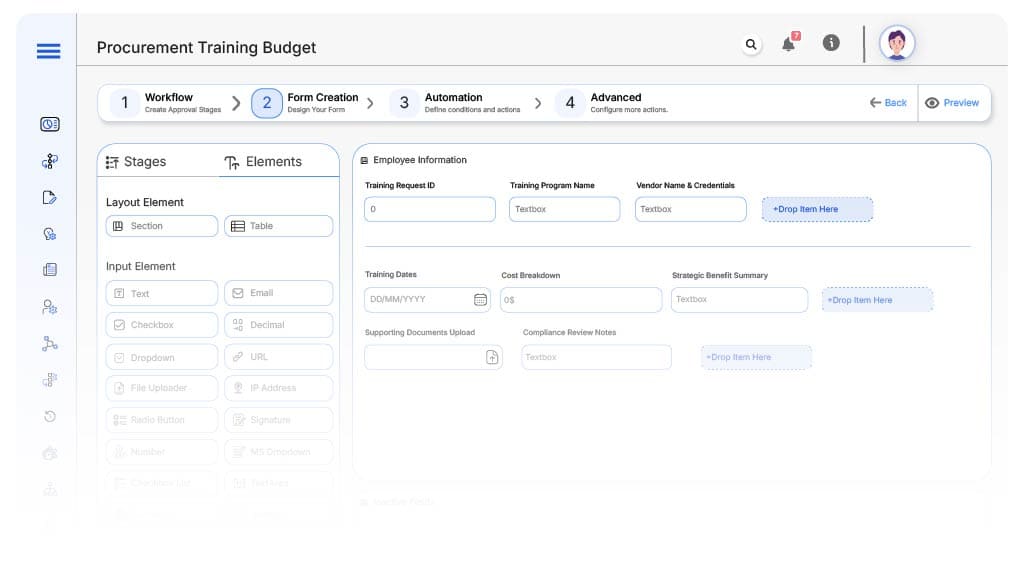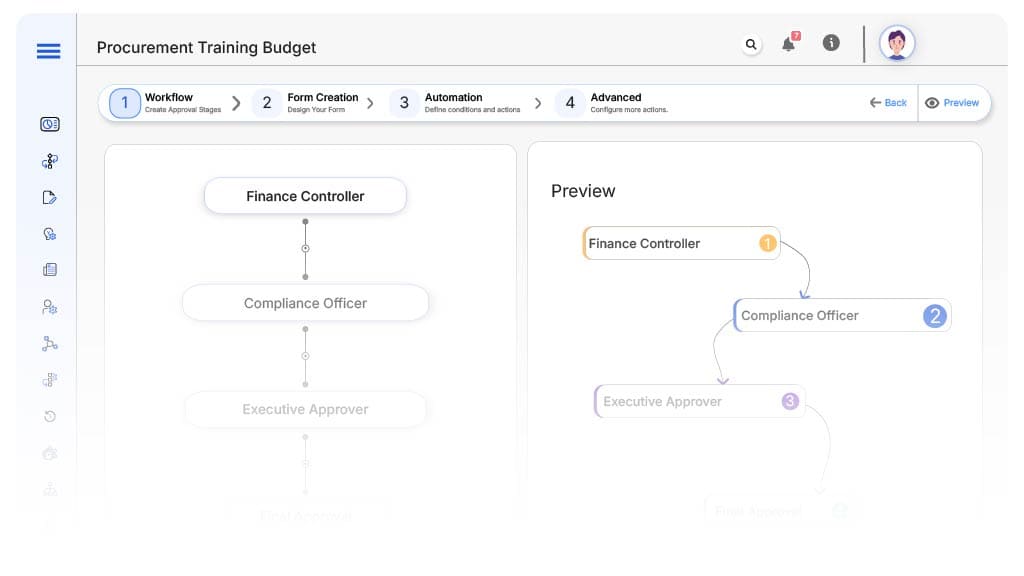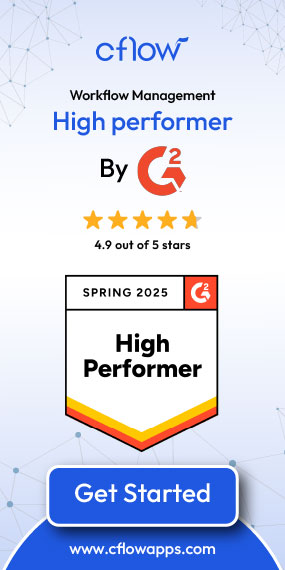- Cflow
- Procurement Training Budget Automation
Procurement Training Budget Automation

Clow Team

Procurement teams require ongoing training to stay updated on vendor management, negotiation tactics, compliance regulations, and supply chain best practices. Approving training budgets manually often leads to delayed upskilling, overspending, and compliance gaps. Recent industry research shows that organizations automating procurement training budgets achieve 30% faster approvals and 25% better budget utilization.
Without automation, procurement managers, finance controllers, and compliance officers struggle to coordinate approvals, monitor spending limits, and validate vendor training providers. This guide walks you through exactly how Cflow automates Procurement Training Budget Approval, from request submission to final budget allocation.
What Is Procurement Training Budget Process?
The Procurement Training Budget Process governs how procurement departments request, review, and approve funding for professional training programs, certifications, and workshops for procurement staff.
Each request involves justification for training, vendor evaluation, budget allocation checks, and multiple layers of approvals involving procurement leadership, finance, compliance, and executives.
Recent industry research shows organizations with automated training budget approvals see up to 25% fewer budget overruns and improved alignment with organizational learning goals.
Why Procurement Training Budget Automation Matters for Organizations
Cost Control
Vendor Validation
Compliance Assurance
Transparency
Faster Workforce Upskilling
Key Benefits of Automating Procurement Training Budget with Cflow
- Centralized Training Budget Requests: Cflow provides a unified form for procurement managers to request training allocations. The form includes training type, vendor, budget, and ROI rationale. Centralization ensures consistency, reduces manual errors, and makes it easy to track and prioritize upskilling initiatives across the procurement team.
- Role-Based Approval Routing: Requests are automatically routed based on training cost, department, or strategic importance. For example, certifications over a set amount may require finance and executive approval, while others go through team leads. Cflow ensures efficient and compliant review paths.
- Budget Visibility & Auto-Tracking: Cflow links training requests with allocated learning budgets. Dashboards show available funds, approved spend, and forecasted utilization. This transparency helps procurement heads manage yearly training plans without overshooting budgets or delaying critical certifications.
- Document Upload & Feedback Capture: Requesters can upload course brochures, schedules, and expected outcomes. Post-training, Cflow can trigger automated feedback forms and learning assessments. This closes the loop on budget use and helps improve future training decisions.
- Audit-Ready Logs & Mobile Access: Every approval, change, and expense is logged and time-stamped. Procurement and finance leaders can track training ROI from anywhere using Cflow’s mobile interface, ensuring agility in budget handling and compliance readiness.
Get the best value for money with Cflow
User Roles & Permissions
Procurement Manager (Initiator)
- Responsibilities: Submits training budget requests with cost details, vendor information, and strategic rationale.
- Cflow Permission Level: Submit Form.
- Mapping: “Procurement Team.”
Finance Controller
- Responsibilities: Reviews budget availability and financial impact.
- Cflow Permission Level: Approve/Reject.
- Mapping: “Finance Group.”
Compliance Officer
- Responsibilities: Validates vendor compliance, certifications, and regulatory adherence.
- Cflow Permission Level: Approve/Reject.
- Mapping: “Compliance Group.”
Executive Approver
- Responsibilities: Provides final sign-off for high-value training investments.
- Cflow Permission Level: Approve/Reject.
- Mapping: “Executive Board.”
Discover why teams choose Cflow
Form Design & Field Definitions

Field Label: Training Request ID
- Type: Autonumber
- Auto-Populate: Generated on submission.
Field Label: Training Program Name
- Type: Text
- Logic/Rules: Mandatory.
Field Label: Vendor Name & Credentials
- Type: Text Area
- Logic/Rules: Mandatory.
Field Label: Training Dates
- Type: Date Range Picker
- Logic/Rules: Mandatory.
Field Label: Cost Breakdown
- Type: Currency Field
- Logic/Rules: Mandatory.
Field Label: Strategic Benefit Summary
- Type: Text Area
- Logic/Rules: Mandatory.
Field Label: Supporting Documents Upload
- Type: File Upload
- Logic/Rules: Mandatory.
Field Label: Compliance Review Notes
- Type: Text Area
- Logic/Rules: Mandatory for Compliance.
Field Label: Executive Final Approval
- Type: Checkbox
- Logic/Rules: Mandatory for final sign-off.
Transform your Workflow with AI fusion
Approval Flow & Routing Logic

Submission → Finance Controller
- Status Name: Pending Budget Review
- Notification Template: “Hi Finance, procurement training request submitted for budget validation.”
- On Approve: Moves to Compliance Officer.
- On Reject: Returns to Procurement Manager.
- Escalation: Reminder after 1 day.
Finance Controller → Compliance Officer
- Status Name: Pending Compliance Review
- Notification Template: “Hi Compliance, training vendor requires regulatory verification.”
- On Approve: Moves to Executive Approver.
- On Reject: Returns to Finance Controller.
- Escalation: Reminder after 1 day.
Compliance Officer → Executive Approver
- Status Name: Pending Executive Approval
- Notification Template: “Hi Executive, procurement training request ready for final authorization.”
- On Approve: Moves to Budget Approved.
- On Reject: Returns to Compliance Officer.
- Escalation: Reminder after 1 day.
Final → Budget Approved
- Status Name: Budget Approved
- Notification Template: “Procurement training budget fully approved. Proceed with vendor engagement.”
Transform your AI-powered approvals
Implementation Steps in Cflow
Create a new workflow
Design the form
Set up User Roles/Groups
Build the process flow diagram
Configure notifications
Set conditional logic
Save and publish workflow
Activate process.
Test with a sample request
Adjust logic if needed
Go live
Example Journey: Vendor Negotiation Workshop Request
FAQ's
Unleash the full potential of your AI-powered Workflow

